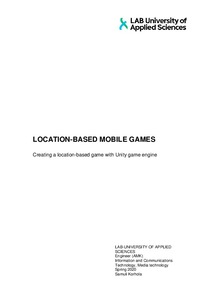Development of a Swimming Game AI
Chichkanov, Ilia (2024)
Chichkanov, Ilia
2024
All rights reserved. This publication is copyrighted. You may download, display and print it for Your own personal use. Commercial use is prohibited.
Julkaisun pysyvä osoite on
https://urn.fi/URN:NBN:fi:amk-2024121736574
https://urn.fi/URN:NBN:fi:amk-2024121736574
Tiivistelmä
In the realm of game development, the creation of intelligent AI (artificial intelligence) systems has become increasingly crucial for enhancing player engagement and experience. This work focused on designing and implementing a comprehensive AI system for the Thalassophobia project, with specific objectives aimed at implementing dynamic decision-making and optimizing navigation for AI characters.
Utilizing the Unreal Engine, both visual scripting through blueprints and C++ programming were leveraged to create a modular system. This system incorporated behavior trees for decision-making and a custom pathfinding plugin for navigation. Several AI components were developed, including perception systems that allowed AI characters to detect and respond to players, a path-following system enabling characters to navigate predefined paths, and robust behavior tree structures that manage complex decision-making processes.
The theoretical foundation included an analysis of various decision-making systems, outlining the advantages and limitations of each approach. While a Goal-Oriented Action Planning (GOAP) system would be ideal for dynamic AI behavior, it was found that the usage of Unreal Engine necessitated a consideration of behavior trees, which are also suitable for creating complex and dynamic behaviors due to their modularity, scalability, and ease of debugging. Furthermore, the thesis explored spatial representations, focusing on how AI can interpret and navigate through 3D environments, which is essential for creating believable and immersive interactions.
Results demonstrated that the AI system successfully managed intricate interactions and navigation scenarios, allowing characters to exhibit realistic and adaptive behaviors. The AI was able to switch between patrolling, roaming, attacking, investigating, and fleeing behaviors based on environmental cues and player actions, facilitating realistic interactions. Positive feedback was received from Varattu Valo Games Oy, highlighting the effectiveness and usability of the system in enhancing gameplay.
Conclusions drawn indicated that the developed AI system is not only scalable and modular but also serves as a viable solution for other projects requiring swimming AI. Additionally, the work provides valuable insights for game developers pursuing similar objectives, offering a comprehensive reference for integrating advanced AI capabilities into their projects.
Utilizing the Unreal Engine, both visual scripting through blueprints and C++ programming were leveraged to create a modular system. This system incorporated behavior trees for decision-making and a custom pathfinding plugin for navigation. Several AI components were developed, including perception systems that allowed AI characters to detect and respond to players, a path-following system enabling characters to navigate predefined paths, and robust behavior tree structures that manage complex decision-making processes.
The theoretical foundation included an analysis of various decision-making systems, outlining the advantages and limitations of each approach. While a Goal-Oriented Action Planning (GOAP) system would be ideal for dynamic AI behavior, it was found that the usage of Unreal Engine necessitated a consideration of behavior trees, which are also suitable for creating complex and dynamic behaviors due to their modularity, scalability, and ease of debugging. Furthermore, the thesis explored spatial representations, focusing on how AI can interpret and navigate through 3D environments, which is essential for creating believable and immersive interactions.
Results demonstrated that the AI system successfully managed intricate interactions and navigation scenarios, allowing characters to exhibit realistic and adaptive behaviors. The AI was able to switch between patrolling, roaming, attacking, investigating, and fleeing behaviors based on environmental cues and player actions, facilitating realistic interactions. Positive feedback was received from Varattu Valo Games Oy, highlighting the effectiveness and usability of the system in enhancing gameplay.
Conclusions drawn indicated that the developed AI system is not only scalable and modular but also serves as a viable solution for other projects requiring swimming AI. Additionally, the work provides valuable insights for game developers pursuing similar objectives, offering a comprehensive reference for integrating advanced AI capabilities into their projects.
Kokoelmat
Samankaltainen aineisto
Näytetään aineisto, joilla on samankaltaisia nimekkeitä, tekijöitä tai asiasanoja.
-
Game Development in Unity : Game Production, Game Mechanics and the Effects of Gaming
Dansie, Jason (Metropolia Ammattikorkeakoulu, 2013)The goal of this thesis is to examine how video games are designed and to see how differ-ent game mechanics work and how to use them in the development of a game, as well as examine what are both the positive and negative ... -
Location-based mobile games : creating a location-based game with the Unity game engine
Korhola, Samuli (2020)The subject of this thesis is location-based mobile games. Location-based mobile games are a way for mobile games to combine reality with virtual worlds and thus re-define the gaming experience. This thesis presents ... -
”WE WANT A 3D GAME” : Customer expectations for the games company when buying a serious game
Sorppanen, Mikko (Oulun seudun ammattikorkeakoulu, 2012)All digital games are not used for entertainment. Some of them can also be used for non-entertainment purposes and these games are called serious games. This thesis is carried out in co-operation with one Finnish games ...



